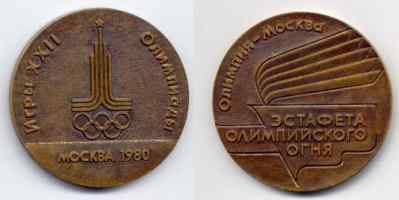Torch and Torch Relay
| The Torch, the Lamp for the Spare Flame,
the Ceremonial Cups
The most important feature of the relay was the torch. Work on it was begun in 1978. It was first proposed to use pyrotechnic components as fuel for the torch. However tests had shown that the high burning temperature and the build-up of waste called for great care in the use of the torch. This first proposition was only used in the creation of a variant of the torch which was to be carried around the stadiums (20 of this type were produced). In general it was decided to use liquid gas (a propane-butane mix) as a fuel, for this could guarantee a regular flame and an optimum weight along with complete safety for the runner. A group of Leningrad engineers under the direction of Boris Tuchin constructed a model torch over a very short period of time. After full testing it was recommended for series production. The torch of the Moscow Olympics, in its construction and its outside appearance, did not resemble its predecessors. Its basic elements comprised a burner section, a ringed cup and protective screen, made from an aluminium alloy, along with the torch handle containing the gas reservoir. (See Fig...) The cup and the screen were golden yellow while the burner section and the handle were of a silvery shade. |
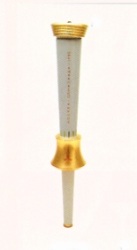 |
Olympic champion Sergei Belov running up to the Bowl |
| Description: | Moscow logo and legend in red |
|---|---|
| Material: | Alluminum alloy, gray and gold |
| Fuel: | Fluid gas, propane and butane |
| Torch measure: | Lenght: 56 cm Weight: 700 gr |
| Torches total: | 5,000 |
| Design by: | Boris Tutschin |
| Manufacturer: | |
| Date of the torch relay: | 19. June - 19. July 1980 |
| Duration: | 31 days |
| Numbers of runners: | ~ 5,000 |
| Distance total: | 4.915 km |
| Name of the last runner: | Sergej Belov |
A group of Moscow engineers under the direction of Alexandre Sergeev worked on two variants of the cup-a Small Cup (diameter 240 mm) and a Large Cup (diameter 750 mm). The fuel for both was a mixture based on dry spirit. The Large Cup was collapsible which allowed it to be assembled or taken apart quickly and to be transported over any distance. Around the burner of the Large Cup the words "Olympia-Athens-Sofia- Bucharest-Moscow" were worked in metal. Twelve of the Large Cups were manufactured by Moscow enterprises. Some of these were sent to the NOCs of Greece, Bulgaria, Romania and to the Olympic cities of Tallinn, Leningrad, Kiev and Minsk. The rest were used during the course of the relay. Fifty of the Small Cups were handed over to the republican and region organising committees on the territory of the USSR. 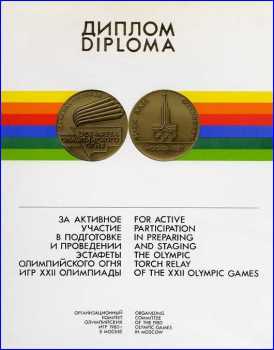
|
| The Torch Relay
During the preparation for the relay various
routes which had been suggested were looked at, in particular the proposals
by National Olympic committees that the Olympic torch should be carried
through many of the countries of Europe or, indeed, on a round the world
run. This however demanded a considerable expense and a great deal of time.
The OCOG- 80 proposed to organise the relay along the shortest possible
route. It was proposed to run the relay of the Olympic flame from Greece,
through Bulgaria and Romania and from there across the USSR and the decision
was confirmed at the 80th Session of the IOC in May 1978. The overall length
of the route was 5,000 km including 1,170 on the territory of Greece, 935
in Bulgaria, 593 in Romania and 2,302 in the USSR. The whole route was divided into 1,000-m stages
(some of the stages that ran through towns were slightly shorter). It was
planned to take on average 4-5 minutes to cover each kilometre of the route.
On some stages through Bulgaria and Romania the organisers of the festive
ceremonies proposed to include cyclists and horsemen in the relay. One
hundred and thirty-five ceremonies to meet the Olympic flame were planned
along the route including 23 in Greece, 44 in Bulgaria, 27 in Romania and
41 in the USSR. In fact, there were 142 ceremonies. The relay was to be
run only in the daytime, except for the lap from Olympia to Athens, which
according to tradition did not envisage any stopover. |
| Country | Date | Distance | Runners | Torches |
|---|---|---|---|---|
| Greece | 19.06. - 25.06.1980 | 1,170 km | ||
| Bulgaria | 25.06. - 01.07.1980 | 924 km | ||
| Romania | 01.07. - 05.07.1980 | 593 km | ||
| Soviet Union | 05.07. - 19.07.1980 | 2,228 km | ||
| Total: | 4,915 km | ~ 5,000 | ~ 5,000 |
|
Preparation for the relay called for close
cooperation between the OCOG- 80 and the NOCs of Greece, Bulgaria and Romania,
with whom relevant agreements were concluded. In 1978-1979, on the initiative
of the Organising Committee, local organising committees were formed in
the Republics, regions, districts, and towns of the USSR whose territory
was crossed by the route of the relay. These committees were to prepare
for the relay and assist its passage through their territory. Formed on
a voluntary basis through the local Soviets of People's Deputies, these
committees were to draw a wide range of enterprises, institutions, collective
farms, public organisations and individual citizens into their work. Preparations
for the relay were accompanied by publicity about physical culture and
sport, which created a new influx of people into sports clubs and groups.
New forms of mass competition began to emerge, for example such open athletics
matches as "The Olympic Kilometre", "The Olympic Torch", 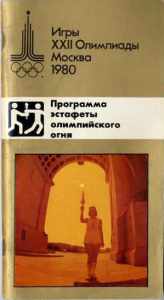 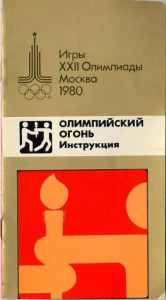

The torch bearers were handpicked by sports
and public organisations. The right to carry the Olympic torch was considered
to be a great honour. In choosing the runners the basic criteria were the
personal sports achievement of the candidate, the ability to complete the
1,000 m distance in no more than five minutes, the contribution which each
candidate had made to sports organisations, and medical approval. (Source document: Official Report 1980, Vol. 2, page 262, 264) |

